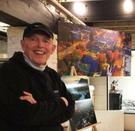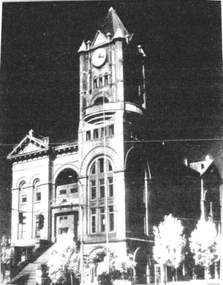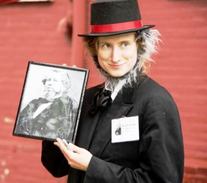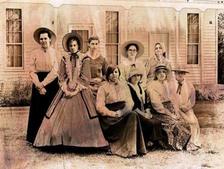 Ron with his Showcased Art
Ron with his Showcased Art  [Ron Cooper, Statesman Journal, 1971]
[Ron Cooper, Statesman Journal, 1971]
 Ron with his Showcased Art Ron with his Showcased Art Ron is a native Oregonian from the east side of the state, Ontario and later LaGrande. His first job after college proved to be rather hazardous, so he went looking for something else. He landed at the LaGrande Observer as their sports editor and photographer. Ron's photography skills are self-taught, garnered from reading books in the public libraries and on-the-job training "opportunities." He has learned something from every photographer with whom he has worked, and continues to push the edge on what his camera can do. He says he's having more fun than ever. During his newspaper career, his fingers and hands were constantly stained from the chemicals used to develop the photographic film. All the developing and printing was done by hand, one negative at a time. Often his publication deadline called for the photo to be available as soon as possible, so he helped the process along manually. Special effects were achieved by manipulating the timing in the various chemical baths, again by hand.  [Ron Cooper, Statesman Journal, 1971] [Ron Cooper, Statesman Journal, 1971] Being a newspaper in a relatively quiet town had its drawbacks. Salem didn't have a lot of "spot news" happening to fulfill the requirement for a major photograph for Page One. Typically, his editor would suggest the type of photo he was looking for, and Ron would head out to see if he could capture something worthy of the first page. He considered himself the "eyes of the community" and often brought back something he found interesting enough to share with the community. Some of those photographs have become quite iconic. Take the one to the right, a shot of the old Salem City Hall the night before its scheduled demolition in 1971. This photo was so popular that the newspaper sold more than 100 copies to the public--copies that were personally and individually produced by Ron. Ironically, however, Ron does not have a copy himself. We surprised him with this scanned version we found in the Newspaper.com archives. Throughout the years of his career, the scope, mechanics, and art of photography changed significantly. From leaving a Trailblazers game before the end to ensure his photo was ready for the publishing deadline, to using the first of the new digital cameras, to the demand for online news content, Ron has experienced as much change in the business of photography as did his earliest inventive counterparts. He laughingly admits that he was sure that digital cameras would never overtake the SLR cameras because their photos were of such terrible quality--ha! Ron's character-capturing photographs line the office walls of local health practitioners, hospitals, public buildings and institutions. The photographs that folks routinely use to identify the area and personality of Salem are most likely the work of Ron Cooper. Here are a few you are sure to recognize: In retirement, Ron continues to hone his craft and embrace the new technology available to modern photographers. He has become adept with image-editing software (no more chemical burns), and is excited when a new format allows him to capture a moment with a new perspective. His latest endeavors include the use of a photographic drone, allowing him freedom from physical location constraints and opening up amazing new photo opportunities. As an historian and researcher, I am indebted to Ron for his images which chronicle the changes in Salem over the years. As citizens of the region, we are indebted to Ron for reminding us of the amazingly beautiful area in which we are privileged to live and work. And as Salemites, we are indebted to Ron for capturing the unique facets of our character through the places and events that surround us. Keep pushing the edge, Ron.
 Kylie Pine as John B. Preston, Surveyor General of Oregon, 2016 Kylie Pine as John B. Preston, Surveyor General of Oregon, 2016 ,August 3, 2017 Episode. The picture to the left exemplifies one of the many hats Kylie Pine wears as the curator and collections manager at the Willamette Heritage Center, a five-acre complex on the grounds of the former Thomas Kay Woolen Mill which contains three of the oldest buildings in the Pacific Northwest, a small retail "mall," exhibit and instructional space, and a staffed research library and archive. In this 2016 picture, she is donning her visitor experience manager's hat, enhancing the experience of participants in WHC's annual Oregon Trail LIve event. This event is based on the popular computer game developed in Oregon and allows teams of "settlers" to experience challenges similar to what our early pioneers might have faced coming to Oregon--connecting to history through a fun event. This annual event is held each summer, with September 9 being the date for this year's event.  Teen Interpreters at WHC, 2015 Teen Interpreters at WHC, 2015 Kylie advised us that as Curator, she is responsible for all the collections--from small buttons to the largest of industrial machinery, for developing, implementing and maintaining every exhibit, and for ensuring that the visitors have an optimum experience interacting with the exhibits. She has a full working background at WHC, beginning with her involvement in the Teen Interpreters program in high school which lead her to study this field, so she well knows the ins and outs of working with and among historic resources. WHC's exhibit calendar typically contains an early Spring Exhibit, the Heritage International. For this exhibit, a theme is chosen and cultural/heritage organizations throughout the area collaborate by loaning artifacts and information that help describe the theme. In the Summer, they try to produce a lighter, fun/quirky exhibit that family members of all ages will enjoy. For their major Fall Exhibit, they focus on the history of textiles, which are such a major part of their own history. These exhibits do not simply 'happen' according to the adopted schedule. WHC currently has a five-year calendar for developing new exhibits. This allows staff and members of an advising committee to determine the theme, find the necessary funding, and select the artifacts which best describe the theme. Producing quality exhibits requires a high level of funds, so this nonprofit organization must continually research fundraising opportunities.
We in the Salem area have a treasure trove of history available to us at Willamette Heritage Center, and we also have a treasure in Kylie's tutelage. She carries a pretty large burden of responsibility for such a petite person, but Kylie seems to handle it all effortlessly--largely due, we suspect, to her passion for history and her commitment of service to the visitors. Visit the WHC as soon as you can, and then go back again. You can learn more about exhibits and events at the WHC website, where you can also make contact with Kylie. We're going to leave you with some photos of the recent installation of the NEW permanent exhibit, the 1909 Oregon & California Railroad Caboose #507, as well as a couple from an earlier attempt that didn't go so well. Posted by Deb Meaghers - All the photographs shown are from the WHC Facebook page.
|
Your HostsDeb Meaghers and Christy Van Heukelem, historians and authors, are passionate about the history of Salem and the entire mid-Willamette Valley. We love sharing our enthusiasm for our rich historic legacy with others. Archives
May 2020
|